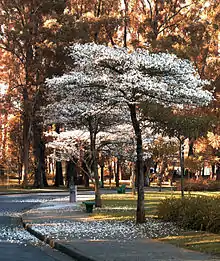| Tabebuia roseo-alba | |
|---|---|
 | |
| Scientific classification | |
| Kingdom: | Plantae |
| Clade: | Tracheophytes |
| Clade: | Angiosperms |
| Clade: | Eudicots |
| Clade: | Asterids |
| Order: | Lamiales |
| Family: | Bignoniaceae |
| Genus: | Tabebuia |
| Species: | T. roseo-alba |
| Binomial name | |
| Tabebuia roseo-alba (Ridl.) Sandwith | |
| Synonyms[1] | |
|
List
| |
Tabebuia roseo-alba, known as white ipê, ipê-branco or lapacho blanco, is a tree native to Cerrado and Pantanal vegetation in Brazil, but also appears in Argentina (especially in the "Esteros del Ibera" wetlands) and more rarely in Paraguay.
This plant is frequently used as an ornamental plant and honey plant in Brazil and Argentina.[2] On the other hand, its flowers seem to be less popular with many hummingbirds than those of other Tabebuia, being visited mostly by the occasional generalist species like the gilded sapphire (Hylocharis chrysura).[3]
References
Wikimedia Commons has media related to Tabebuia roseoalba.
- ↑ "The Plant List: A Working List of All Plant Species". Retrieved June 3, 2014.
- ↑ Pott & Pott (1994)
- ↑ Baza Mendonça & dos Anjos (2005)
- Baza Mendonça, Luciana & dos Anjos, Luiz (2005): Beija-flores (Aves, Trochilidae) e seus recursos florais em uma área urbana do Sul do Brasil [Hummingbirds (Aves, Trochilidae) and their flowers in an urban area of southern Brazil]. [Portuguese with English abstract] Revista Brasileira de Zoologia 22(1): 51–59. doi:10.1590/S0101-81752005000100007 PDF fulltext
- Pott, A. & Pott, V.J. (1994): Plantas do Pantanal [Plants of Pantanal]. [In Portuguese] EMBRAPA. ISBN 85-85007-36-2
External links
This article is issued from Wikipedia. The text is licensed under Creative Commons - Attribution - Sharealike. Additional terms may apply for the media files.